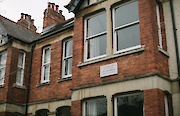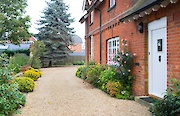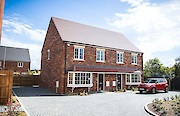


Mortgage Advisor & Director

Mortgage Advisor & Director

Concrete houses were popularised at the end of World War II, to help with the post-war housing crisis; although pre-cast reinforced concrete homes were largely later condemned due to poor construction quality. However, there are a range of more modern concrete construction homes that are more reliable.
If you’re looking to buy a concrete house, read on to find out how to get the mortgage that you need, and what to be aware of.
Why is it harder to get a mortgage on a concrete house?
Put simply, it’s harder due to the increased risk involved in lending on ‘non-standard’ construction properties. This means that there are likely to be fewer lenders who are willing to approve your mortgage application.
To further complicate matters, there are different types of concrete homes, and which types lenders deem acceptable varies from one lender to the next. This is why it can be very beneficial to speak to a mortgage broker with experience of securing finance for non-standard construction, and particularly concrete homes.
The different types of concrete construction properties are:
- PRC (precast reinforced concrete): These houses were intended to be temporary homes and were largely built after World War II. Lenders are much more cautious about lending on this type of property due to their tendency to crumble. A PRC Completion Certificate to confirm that the property has been reinforced to an approved safety standard can help, and some lenders approve mortgages where the property has this certification.
- In Situ Poured Concrete (IPC): Also known as poured concrete houses, these properties may also be acceptable to lenders if they have undergone suitable renovation to make them structurally sound.
- Large Panel System (LPS) concrete homes: These can be very difficult to secure a mortgage for due to being notorious for collapse. It was predominantly used to construct high rise flats, which are known to lose value quickly in a low market.
Although it can be difficult to get a mortgage on a concrete home, it’s not impossible, but it is recommended that you talk to a broker first to find out what your options are.
Eligibility criteria
Alongside usual mortgage criteria, lenders are likely to consider a range of property-specific criteria. This might include:
- Structural repair - many concrete properties will need to have undergone reinforcement in order for a mortgage lender to approve the loan. If there are other properties attached (e.g semi-detached) then this will likely apply to both properties
- Number of storeys - lenders often have a cap on how tall a concrete property that they will approve a mortgage on. This is often 2, meaning traditional 2 floor houses are fine, but low and high rise flats can be harder to finance
- Certification and guarantees - For repaired properties, there will need to be a relevant certificate to guarantee that the concrete meets current safety standards, before a lender is willing to approve the loan
- The LTV of your borrowing - This will also be capped at around 50% on many concrete houses, meaning you’ll need a large deposit. This will also vary depending on the type of concrete property you are planning to buy - it may be possible to borrow as much as 75% on a less risky concrete property
- Survey - You’ll need to arrange a full structural survey for any type of concrete house mortgage application
How to get a mortgage on a concrete house
It’s possible to make the majority of concrete construction properties mortgageable with structural improvements. Improving insulation or adding a brick skin can also reduce the risk and help to convince lenders that the property is sound.
It’s a good idea to employ a surveyor with specific experience in concrete properties, and buying in an area where concrete properties are commonplace can also be beneficial.
You may also consider looking at green mortgages, especially if your concrete property has ecological benefits. Some modern concrete prefab homes are designed to be energy efficient, which could influence lender decisions on a green mortgage application.
As well as making sure that the property is as mortgageable as possible, it’s also highly recommended that you speak to a broker with experience in securing finance for this type of home. At Teito, we can help with all sorts of non-standard construction mortgage applications, so get in touch below to find out more.

Get tailored mortgage advice for concrete home buyers
Which lenders are available?
There are a range of lenders who will consider concrete construction homes, but keep in mind that not all of them will consider all types. For example, Natwest and Halifax offer mortgages on concrete houses, but this is on a case-by-case basis, if they have been reinforced. This also applies to TSB, Nationwide, and Virgin Money, however, each has their own guidance on the length of the PRC guarantee, usually this ranges from 30-60 years.
If you’re looking at a non-reinforced PRC home then there are very few lenders who will consider your application and it’s unlikely that you’ll be able to borrow more than 50% LTV.
Are the rates higher for mortgages on concrete houses?
Any property that lenders see as presenting an increased risk are likely to have higher mortgage interest-rates than a standard brick and mortar home. It might be possible to get better rates with a more modern concrete home if you qualify for a green mortgage, however, as these often offer better rates or cash back.
Why choose Teito for your non-standard construction mortgage?
Put simply, because we have brokers on our team who specialise in non-standard construction mortgages, and their expertise could help you save time and money.
To ensure that you secure the most suitable and competitive mortgage for a concrete property, it’s best to speak to a broker with knowledge and experience in that area. There are 11 types of concrete construction properties in the UK, so it’s important to find a lender whose criteria matches your needs.
At Teito, our experienced brokers know which lenders accept which type of concrete construction home, due to their in-depth knowledge of this market. Your first consultation is always free, so reach out to access our 5-star rated service and secure the finance you need for your unique home choice today - get started here.
FAQs
It’s certainly possible to get a buy-to-let mortgage for a concrete house, but it’s likely you’ll be up against similar challenges as those buying these properties for residential use.
Keep in mind that you would likely need to meet stricter standards if you plan to let out a property, such as a minimum EPC rating, so it’s a good idea to ensure any non-standard property you’re considering will meet them.
Choosing an Adviser
Selecting a qualified and experienced mortgage adviser is of great importance. To choose a suitable adviser, evaluate their qualifications, experience, and reputation, and ensure they are regulated by the Financial Conduct Authority (FCA).
Read reviews from previous clients and make sure they provide a clear explanation of the products and services they offer, as well as the fees and charges associated with them.















































































































































